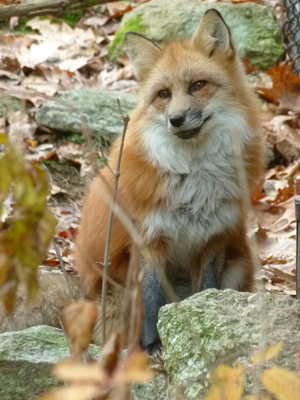
Foxes
A glimpse of a cherry-red fox against the backdrop of snow-covered fields is a sight to behold.
Both red and gray foxes live in the Granite State, but the red fox is far more abundant and has a widespread range. Gray foxes are more common in southern New Hampshire, and are rarely recorded in Coos County. Unlike red foxes, gray foxes (which can climb trees) are able to co-exist with coyotes.
The larger of the two foxes, the red fox has a sleek, lean appearance, compared to the more stout and robust gray fox. The red fox is generally reddish, though shades may vary, and has a distinct white tip on its tail. The gray fox has a line of black-tipped fur down its back. The upper part of its gray coat is grizzled with guard hairs banded with gray, black and white; the under parts range from light-colored, buff and white to reddish. The gray fox's tail is tipped with black.

The gray fox prefers more wooded and brushy habitat, while its cousin, the red fox, inhabits fields and farm country. Gray foxes have always been here, but have never been as numerous as red foxes. The gray fox's diet changes with the season, ranging from grasshoppers, grapes and apples in the summer months, to small mammals like mice, voles and squirrels at other times of year. In the last decade, New Hampshire trappers have taken about 100 gray fox each year.
Like gray foxes, red foxes can eat a variety of foods, including insects and fruit. They are well known for capturing mice and voles, which generally make up most of their diet. They will also eat larger prey, such as woodchucks, rabbits and the occasional housecat.
For many years, hunting red fox with hounds was a favored sport. In the 1930s and 1940s, as many as 5,000 foxes were taken in New Hampshire each year. Today, hunters take only a dozen or two foxes each year, and trappers have harvested an average of 310 red foxes a year over the past ten years.
Red foxes are susceptible to several diseases, including mange, rabies, distemper and parvovirus. In 1994, the red fox rabies virus spread from Vermont into Coos and northern Grafton counties. A separate strain of rabies is spreading north from Massachusetts via raccoons. Unfortunately, we can expect both these strains of rabies to continue their spread across the state.
--Eric Orff, Wildife Biologist
The gray and red fox photos are from the Squam Lakes Natural Science Center in Holderness, NH. Visit their page on Gray Fox at https://www.nhnature.org/visit/animal_info_sheets/gray_fox.php
